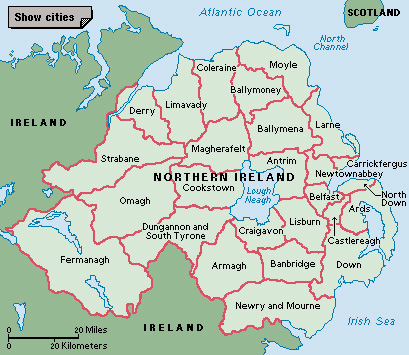Antrim is a historic market town in eastern Northern Ireland. It stands on the banks of the Six Mile Water, a river that empties into the northeastern corner of Lough Neagh (Lake Neagh). Many Antrim residents work in Belfast, the capital of Northern Ireland, about 15 miles (24 kilometers) to the southeast.
According to legend, Roman Catholic missionaries established a monastery and settlement near what is now Antrim about A.D. 495. A round tower, built to help defend the monastery from Viking raiders, dates from the 900’s. The tower, known as the Steeple, stands northwest of the town center. Many Presbyterian settlers from Scotland came to Antrim in the early 1600’s, after the English gained control over the region. Antrim was the site of a battle between Presbyterian rebels and the British army during a rebellion led by the United Irishmen in 1798. The United Irishmen was a movement that sought to reform the Irish Parliament by uniting Protestants and Roman Catholics.
The town of Antrim is part of County Antrim, one of Northern Ireland’s six historic counties. Counties ceased to be used as administrative areas in 1973, when county governments were replaced with smaller district councils. From 1973 to 2015, Antrim was the name of a district council area centered on the town of Antrim. In 2015, the Antrim and Newtownabbey local government districts were combined to form a single district called Antrim and Newtownabbey.

